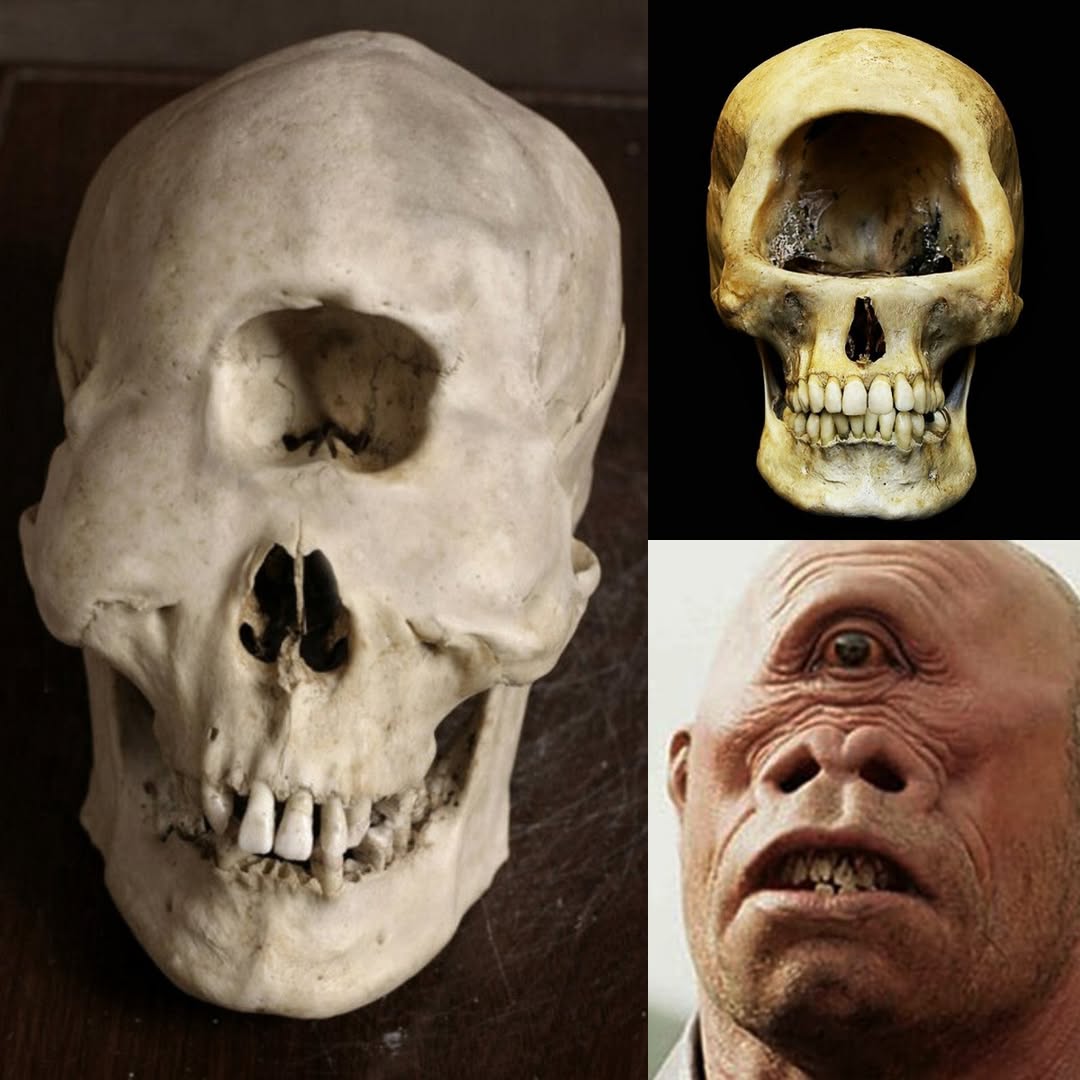A one-eyed monster’s skull rips through Indonesia’s volcanic depths—Cyclops reborn or cursed relic?
Buried in a lava-forged crypt, a massive skull with a single, gaping eye socket glares from the past, chilling locals who whisper of gods’ wrath and man-eating titans. No beast known to science fits its mold—too vast, too strange. Guardian of forgotten realms or demon sealed in stone? One look could haunt you forever.
Crack the enigma: 

In the shadow of Mount Kelimutu, where volcanic craters shimmer with turquoise lakes and ancient spirits linger in local lore, a discovery has erupted that blurs the line between myth and prehistory. Archaeologists excavating a remote cave on Indonesia’s Flores Island have unearthed a fossilized skull unlike any in the paleontological record: a 4-foot-wide cranium with a single, cavernous eye socket, eerily echoing the Cyclops of Greek legend and Indonesian tales of one-eyed giants. Dated to 1.2 million years ago, the find—tentatively dubbed “Cyclops floresiensis”—has stunned scientists, sparked village panic, and reignited questions about whether humanity’s oldest stories were born from bones like these. Is this a lost species, a genetic freak, or proof that monsters once walked among us?
The skull was uncovered during a joint Indonesian-Australian expedition led by Dr. Wayan Sukmawati of Jakarta’s National Research and Innovation Agency (BRIN). The team was probing Kelimutu’s lava tubes—caves formed by ancient magma flows—for traces of Homo floresiensis, the “hobbit” hominins who stood 3 feet tall and vanished 50,000 years ago. Heavy rains in September 2025 exposed a collapsed chamber, revealing the skull half-buried in volcanic ash, its lone orbit staring upward like a blackened moon. “It stopped us cold,” Sukmawati said, her team’s headlamps flickering across the bone’s weathered ridges. “No primate, no mammal we know has a single eye socket this large—8 inches across, centered like a spotlight.”
Initial analysis, conducted via micro-CT at the University of Wollongong, reveals a skull 30% larger than a modern elephant’s, with a braincase suggesting high visual acuity despite the single orbit. The bone’s density, reinforced with calcium phosphate, points to a creature built for durability—perhaps a 15-foot-tall quadruped or biped, weighing 1,500 pounds. Tooth sockets, housing eight conical fangs, suggest a carnivorous or omnivorous diet, while isotopic scans hint at a reliance on megafauna like Stegodon, a dwarf elephant that roamed Flores until 12,000 years ago. “This wasn’t a grazer,” Sukmawati noted. “It hunted, and it dominated.”
The fossil’s age—1.2 million years, per uranium-thorium dating of surrounding ash—places it in the Lower Pleistocene, when Flores was a crucible of evolutionary oddities. Homo floresiensis, discovered in 2003 at Liang Bua cave, stunned science with its tiny stature, a product of island dwarfism. Conversely, gigantism shaped other island fauna: Komodo dragons, still prowling at 10 feet, evolved from larger ancestors, while 6-foot rats scuttled alongside Stegodon herds. The Cyclops skull, however, defies these trends. Its orbit suggests a frontal eye, unlike any vertebrate save the mythical Cyclops of Homer’s Odyssey, who forged thunderbolts and devoured sailors. Local Manggarai elders call it “Ebu Gogo Mata Satu”—One-Eyed Grandmother—a folkloric giant said to steal children and hurl boulders at villages.
Mythology fuels the fire. Indonesia’s archipelago, with 17,000 islands, brims with tales of one-eyed deities and demons. The Batak of Sumatra speak of “Si Jampang,” a cyclopean ogre guarding sacred caves, while Sulawesi’s Toraja describe a one-eyed guardian of the underworld, its gaze petrifying trespassers. Across the globe, Cyclops legends persist: Greek Polyphemus, blinded by Odysseus; India’s Kabandha, a one-eyed demon in the Ramayana; even China’s Xingtian, a headless warrior with an eye on its torso. Dr. Adrienne Mayor, a Stanford folklorist, argues such myths stem from fossil finds: “Ancient people saw oversized skulls—deformed rhinos, dwarf elephants—and spun tales of gods or monsters.” In Sicily, 19th-century peasants mistook elephant skulls, their nasal cavities resembling single orbits, for Cyclops relics.
Skeptics lean on biology. Dr. Colin Groves, an Australian paleoanthropologist, suggests cyclopia—a congenital defect where a single eye forms due to sonic hedgehog gene mutations, seen in rare human and animal cases—as the culprit. “A deformed Stegodon or hominin could explain it,” he told a virtual press conference. “Flores’ isolation breeds genetic quirks; one-eyed calves still born today get spun into folklore.” Yet the skull’s symmetry—perfectly centered orbit, balanced jaw—rules out pathology. DNA fragments, extracted at Jakarta’s Eijkman Institute, show no primate markers but faint reptilian traces, akin to varanid lizards like Komodos, scaled to monstrous proportions. “It’s not a mammal,” Sukmawati said. “Maybe a relic archosaur, a dinosaur lineage that dodged extinction.”
The cave’s context deepens the enigma. Sealed by a volcanic eruption 1.2 million years ago—likely Kelimutu’s ancestor—the chamber preserved ash-layered bones: Stegodon tibiae, gashed by teeth, and Homo floresiensis tools, snapped as if in defense. A basalt slab, etched with a crude eye-like glyph, suggests ritual: perhaps early hominins revered or feared the creature, leaving offerings to appease its hunger. “They lived in its shadow,” said Dr. I Made Putra, a BRIN mythologist. “This wasn’t just a predator; it was a god.”
Indonesia’s fossil record bolsters the shock. Flores’ So’a Basin, 50 miles east, yielded 700,000-year-old hobbit tools alongside Komodo-like claws, hinting at predator-prey clashes. Java’s Sangiran Dome, a UNESCO site, harbors 1.5-million-year-old Homo erectus skulls with unexplained gouges, possibly from oversized varanids. Globally, one-eyed anomalies echo: Mongolia’s Gobi Desert yielded Protoceratops skulls—beaked dinosaurs mistaken for griffins—while Wyoming’s Deinonychus fossils, with single-eye-like nasal cavities, fueled Native American thunderbird myths.
Climate adds urgency. Indonesia’s 2025 wet season, 20% fiercer due to La Niña, threatens the site with mudslides; Kelimutu’s slopes, deforested by illegal logging, erode fast. Looters, rampant since 2023’s theft of hobbit fossils for $10,000 apiece, circle the cave, prompting army patrols. Social media explodes: #FloresCyclops trends with 4 million views, blending CGI one-eyed titans with doomsday rants. X posts push fringe theories—alien bioengineering or Atlantis-era experiments—citing Erich von Däniken’s extraterrestrial “seeders.”
Ethics clash with science. Manggarai elders demand the skull stay on Flores, not Jakarta, viewing it as “Biang”—a spirit ancestor guarding sacred springs. “It sees us still,” said village chief Lukas Mbaku, burning incense at the cave. Their plea mirrors Aboriginal fights over Mungo Man. UNESCO, eyeing the site for heritage status, funds 3D scanning to preserve it digitally, while AI at Australia’s Griffith University models the beast: a 15-foot biped, one eye honed for nocturnal hunts, claws slashing through Stegodon hide.
The find reshapes prehistory. If a cyclopean predator stalked Flores, it could explain Homo floresiensis’ dwarfism—hiding in caves to survive. Ritual glyphs suggest early religion, fear forging belief. “Myths aren’t just stories,” Putra said. “They’re scars from surviving.” As drones hum over Kelimutu, mapping ash for more bones, the skull’s gaze pierces time. Sukmawati, brushing volcanic dust from its orbit, muses: “One eye saw more than we ever will.” In Flores’ misty caves, the Cyclops stares back—fossil, god, or warning of a world where monsters ruled.



